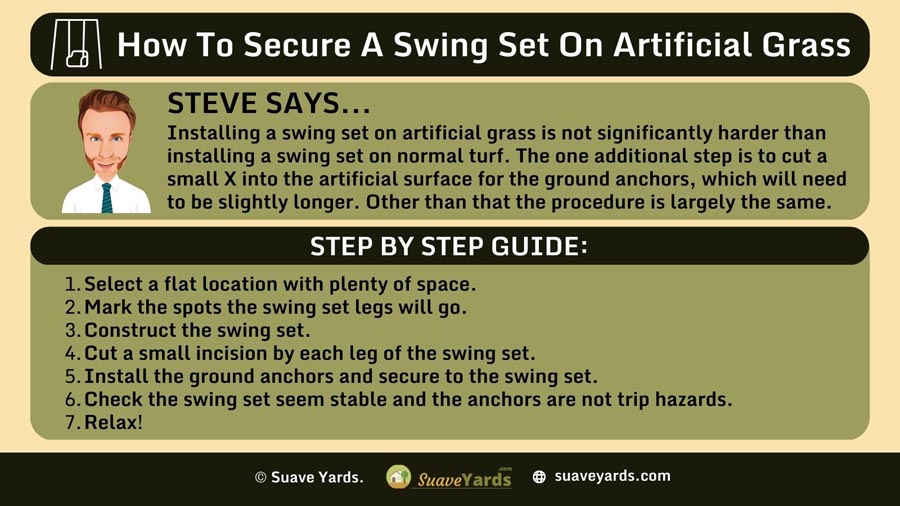
Some people would never dream of replacing their natural turf with artificial grass, whilst others love the thought of having minimal maintenance and no mud.
If you are in the latter category and are considering buying a swing set to keep your children entertained then this article is for you.
A couple of summers ago I helped a close friend of mine install his swing set on artificial grass, so I am going to recount everything I learned that day!
Let’s get started.
How To Secure A Swing Set On Artificial Grass
Installing a swing set on artificial grass is not significantly harder than installing a swing set on normal turf. The one additional step is to cut a small X into the artificial surface for the ground anchors, which will need to be slightly longer. Other than that the procedure is largely the same.
STEP #1: Make Sure the Grass is Installed Properly
I would imagine that by the time you get around to setting up a swing set on your lawn the artificial grass has already been installed.
But nevertheless, it is good practice to run a few checks and make sure it has been laid properly to avoid any problems later on.
Cast your eye over the turf and look for any border stakes or nails, and make sure you keep the swing set away from them or anything exposed.
Hopefully, this won’t be an issue, as artificial grass tends to be installed with joining tape and glue these days ratther than nails, but you should always check.
If you employed a third party to install the artificial grass and have any questions or concerns, discuss them with the responsible company.
Once you have carried out these basic checks then it is time to…
STEP #2: Select a Location

It goes without saying that regardless of what surface you are installing your swing set on, you want it to be as flat as possible.
You also need to be aware of the Consumer Product Safety Commission (CPSC) guidance.
They recommend that a swing set should be:
- Six feet from any structure or obstacle such as a house, shed or fence, etc
- Twice the height of the top bar of the swing set away from any structures to the front or rear. So if you have a swing beam and it is seven feet high, you need 14 feet of open space in front of and behind the swings.
As noted, this is just guidance, but you do want to make sure there is plenty of space around the swing set.
There are a range of other things to consider when selecting a location for a swing set and our post on Where Should You Put A Swing Set In Your Yard goes into a bit more detail on this.
RELATED ===> Buyers Guide: The Best Swing Sets on the Market
STEP #3: X Marks the Spot
When you have chosen the location for your swing set, you want to mark out where you are going to install it on the grass.
Take note of the swing set dimensions and use a marker or tape to identify where each leg/base will go.
STEP #4: Put Together the Swing Set
Once you are certain of where the swing set will go, you can start what is probably the most frustrating and exasperating part of this whole thing.
Constructing the swing set!
I know this rarely goes to plan, so if you find things go slightly askew don’t feel too bad, it happens to us all!
Just exercise a little patience…
STEP #5: Choose Your Anchors

The good news is, if you have got this far you have undoubtedly done the hardest part of the job.
You’ve actually put the swing set together.
Now you are nearly ready to secure it using the anchors.
You will almost certainly be using the standard ground anchors rather than installing it in concrete.
Installing a swing set in concrete is a tricky enough job on normal grass, trying to do so on artificial turf just makes things ten times harder.
Also concrete damages the structural integrity of wooden swing sets, so if your swing set is made of wood that is another reason to avoid using concrete.
When installing a swing set on artificial grass you will need the ground anchors to be slightly long, that is because they have to penetrate the artificial turf and its sub-base before entering the grass.
Ideally the ground anchors should be at least 10 inches long.
STEP #6: Secure the Swing Set to the Anchors
Now you can secure the swing set to the anchors.
You will want to install the anchors as close to the legs of the swing set as possible to minimalize the risk of children tripping over them.
Identify the spot and then use your fingers to separate the fibers of the artificial grass so you can see the silica base.
Using a sharp blade carefully cut a small X in the grass big enough for the anchor to fit in.
The hammer or twist the anchor into place through the X you have just cut.
How you secure the swing set to the anchor will vary depending upon your swing set.
Some use metal straps, some will have pre-drilled holes, sometimes you will need to drill a hole yourself.
As long as you have installed the anchor close enough to the swing set frame, then it should just be a case of following the manufacturer’s instructions.
To be on the safe side loosely install each anchor first, just to safeguard against any discrepancies. Then, when you are sure everything is in place, go back and tighten each anchor securely.
Once this is done give the areas in your artificial turf where you have installed the anchors a quick brush over to settle the fabric back down.
STEP #7: Carry Out Some Final Checks
Now check the stability of the swing set by giving it a good old push and pull in all directions.
If it wobbles significantly, identify which area it is coming from and tighten the respective anchor and install another anchor if necessary.
If it doesn’t, good job!
Have one final walkaround of the swing set and just make sure none of the anchors are trip hazards for any children that might play on it.
Then move onto the last step…
STEP #8: Celebrate and Relax!
Installing a swing set can be a stressful procedure, so you do deserve some kind of celebration!
Just periodically check the swing set over the next couple of weeks, to make sure it still seems safe and secure.
Final Thoughts

Installing a swing set on artificial grass has a number of benefits when done correctly.
There is no maintenance so you don’t need to mow or weed wack around the legs of the swing set, which can be awkward.
There is no mud to be traipsed indoors, and it is more shock absorbent.
If you are not concerned about having real turf in your garden it is a win-win.
Securing a swing set on artificial grass isn’t significantly harder than doing some on a normal lawn either.
Much of the process is the same, with the addition of creating small X-shaped cuts to push the ground anchors through.
Take your time to make sure you do that accurately, and you will be fine.
Good luck!
